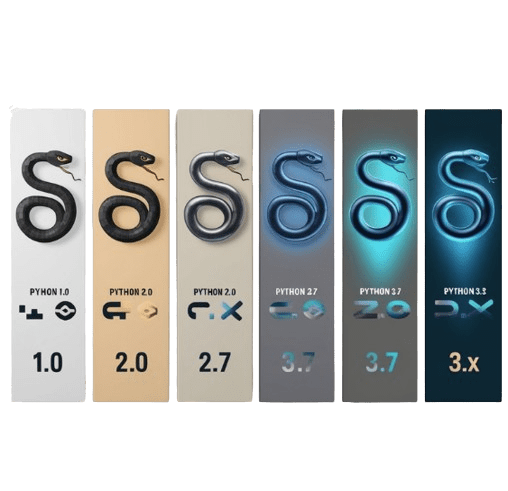
Python, a high-level, interpreted programming language, was conceived by Guido van Rossum in the late 1980s. Van Rossum began working on Python as a successor to the ABC language, which he had been involved with at Centrum Wiskunde & Informatica (CWI) in the Netherlands. Python’s development started in December 1989, and the first public release, Python 0.9.0, came out in February 1991. This early version already featured many of the core components that characterize Python today, such as exception handling, functions, and the core data types: lists, dictionaries, and strings.
Python’s name was inspired by the British comedy series “Monty Python’s Flying Circus,” reflecting Van Rossum’s desire for the language to be fun and approachable. The language was designed with an emphasis on code readability and simplicity, making it accessible to both beginners and experienced programmers.
Python 1.0 was officially released in January 1994. Over the years, Python’s community and ecosystem began to grow significantly. In 2000, Python 2.0 was released, introducing list comprehensions, garbage collection, and many other improvements. Python 2.x series continued to evolve, with Python 2.7, released in 2010, becoming one of the most popular versions for a long time.
In 2008, Python 3.0 was introduced. This major release was not backward compatible with Python 2.x, meaning that code written for Python 2.x would not run unmodified on Python 3.x. Python 3.x was designed to address fundamental design flaws in Python 2.x and to simplify the language, though it took several years for the community to fully transition. Python 3.x introduced several key features, such as print functions as opposed to print statements, new syntax for handling strings, and enhanced standard libraries.
The transition from Python 2 to Python 3 was gradual, and Python 2.7, the last version in the 2.x series, was officially supported until January 1, 2020. After this date, Python 2.x reached its end-of-life, and users were encouraged to migrate to Python 3.
Today, Python is one of the most widely used programming languages in the world, praised for its versatility and ease of use. It finds applications in web development, data analysis, artificial intelligence, scientific computing, and more. Its large standard library and vibrant community contribute to its continued growth and widespread adoption.
Why Python Stands Out in 2024:
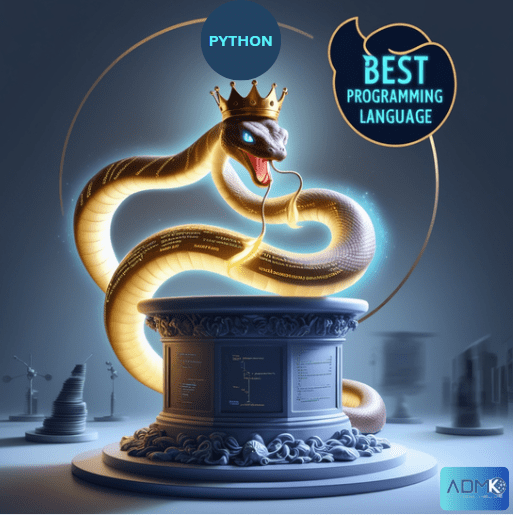
Python has earned a prominent place in the programming world, and its popularity continues to grow into 2024. This widespread acclaim is not without reason; Python excels in various domains thanks to its unique blend of simplicity, versatility, and a thriving ecosystem. This article delves into the key reasons why Python is regarded as one of the best programming languages in 2024.
Readability and Simplicity
One of Python’s most significant advantages is its emphasis on readability and simplicity. Python’s syntax is designed to be clear and straightforward, which makes it easier for developers to write and maintain code in their custom web development projects. The language’s clean syntax reduces the cost of program maintenance and helps new programmers quickly grasp fundamental programming concepts.
Python’s use of indentation to define code blocks instead of braces or keywords contributes to its readable structure. This design choice not only enforces good coding practices but also minimizes the potential for errors related to misalignment. As a result, Python code is often described as “executable pseudocode,” which is beneficial for both novices and experienced developers.
Versatility Across Domains
Python’s versatility is another crucial factor contributing to its popularity. The language is used in various domains, including web development, data science, artificial intelligence (AI), scientific computing, automation, and more.
Web Development:
Python frameworks like Django and Flask make web development straightforward. Django, in particular, is a high-level framework that promotes rapid development and clean, pragmatic design. Flask, on the other hand, provides more flexibility and is used for creating lightweight applications.
Data Science and Machine Learning:
Python is the go-to language for data science and machine learning. Libraries such as NumPy, pandas, Matplotlib, and Scikit-learn provide robust tools for data analysis, manipulation, and visualization. Additionally, TensorFlow and PyTorch have become essential for developing complex machine learning models and deep learning networks.
Scientific Computing:
Python’s role in scientific computing is facilitated by libraries such as SciPy, which provides algorithms and high-level commands for mathematical operations. This makes Python a popular choice for researchers and engineers working on complex scientific problems.
Automation:
Python’s simplicity and extensive standard library make it an excellent tool for scripting and automation. Whether it’s automating repetitive tasks or managing system operations, Python scripts can save time and reduce errors.
Extensive Ecosystem and Libraries
The richness of Python’s ecosystem is one of its strongest points. The language boasts a vast array of libraries and frameworks that cater to different needs, significantly reducing the amount of code developers need to write from scratch.
Package Index (PyPI):
Python Package Index (PyPI) is a repository of over 300,000 packages. This repository allows developers to find and use pre-built code for virtually any task, from web scraping to data analysis.
Community Contributions:
The Python community actively contributes to this ecosystem. Open-source contributions ensure that Python libraries are frequently updated and improved. This collaborative spirit enhances Python’s capabilities and keeps it relevant.
Cross-Platform Compatibility
Python’s cross-platform nature allows developers to write code that runs on multiple operating systems with minimal modifications. This is achieved through Python’s extensive support for various platforms, including Windows, macOS, and Linux. Developers can write code on one platform and deploy it on another with confidence that it will function correctly, which streamlines the development process and broadens the applicability of Python applications.
Strong Community and Support
Python’s strong community is a significant asset. The language benefits from a vibrant and active user base that contributes to its development, offers support, and shares knowledge. Python’s community is known for its inclusiveness and willingness to help newcomers.
Documentation:
Python’s documentation is thorough and well-maintained, providing comprehensive resources for both beginners and advanced users. Official documentation, along with extensive tutorials and guides created by the community, helps developers learn and troubleshoot effectively.
Forums and Discussion Groups:
Online forums like Stack Overflow, Reddit, and specialized Python communities offer platforms for discussing Python-related queries. These forums are invaluable for getting advice, sharing knowledge, and staying updated on best practices and new developments.
Strong Corporate Backing and Industry Adoption
Python’s growth is also fueled by strong support from major technology companies and its adoption across various industries. Companies like Google, Facebook, Amazon, and Microsoft use Python extensively in their operations. This corporate backing not only drives the development of Python but also ensures its continued relevance in industry practices.
Google:
Google’s use of Python for many of its internal systems and external services underscores the language’s capability for handling large-scale applications.
Microsoft:
Microsoft has embraced Python by integrating it into its Azure cloud platform and supporting it in Visual Studio, making it easier for developers to work within the Microsoft ecosystem.
Education and Training
Python’s role as a teaching language is another factor contributing to its dominance. Many educational institutions use Python as the first programming language for teaching programming concepts due to its simplicity and readability. This widespread use in education ensures that new generations of developers are familiar with Python from the outset of their careers.
University Courses:
Python is commonly used in computer science and data science curricula. Its straightforward syntax allows students to focus on learning programming concepts rather than grappling with complex syntax rules.
Online Courses and Bootcamps:
Numerous online platforms and coding bootcamps offer courses in Python, making it accessible to a global audience. These courses cater to various skill levels, from beginners to advanced practitioners, fostering a broad community of Python developers.
Integration and Extensibility
Python’s ability to integrate with other languages and technologies further enhances its appeal. Python can easily interface with code written in languages like C, C++, and Java, allowing developers to leverage existing codebases and libraries. This interoperability is particularly useful for performance-critical applications where Python can be used in conjunction with other languages to optimize efficiency.
Cython and Pyrex:
Tools like Cython and Pyrex enable the creation of Python extensions in C, improving performance while maintaining the simplicity of Python’s syntax.
Jupyter Notebooks:
Jupyter Notebooks provide an interactive environment for data analysis and visualization. They are widely used in data science and machine learning, allowing for seamless integration of Python code with visual outputs and explanatory text.
Future-Proofing and Evolution
Python’s design and development are guided by a forward-looking approach, ensuring that the language evolves to meet the needs of the future. The Python Software Foundation (PSF) and the Python community actively work on improving the language, addressing issues, and introducing new features.
Python Enhancement Proposals (PEPs):
PEPs are the mechanisms by which Python’s features and standards are proposed and discussed. This process allows the language to evolve based on community input and emerging trends.
Python 3.x:
Python 3.x, which has become the standard, introduces features that enhance performance, security, and functionality. The ongoing development of Python 3.x ensures that the language remains relevant and capable of addressing contemporary challenges.
Strong Performance and Scalability
While Python is often criticized for its performance relative to lower-level languages like C++, recent advancements have improved its efficiency. Tools such as Just-In-Time (JIT) compilers and optimization libraries help address performance concerns.
PyPy:
PyPy is an alternative implementation of Python with a JIT compiler that can significantly enhance performance for many applications.
Asynchronous Programming:
Python’s support for asynchronous programming (through frameworks like asyncio) allows for scalable and efficient handling of concurrent operations, making it suitable for high-performance applications.
In summary, Python’s position as one of the best programming languages in 2024 is well-deserved. Its emphasis on readability and simplicity, versatility across domains, extensive ecosystem, cross-platform compatibility, strong community support, corporate backing, educational value, integration capabilities, and ongoing evolution all contribute to its widespread adoption and continued relevance.
Python’s ability to adapt to new challenges while maintaining its core principles of simplicity and clarity ensures that it remains a powerful and attractive choice for developers across various fields. As technology continues to advance, Python’s role as a leading programming language is likely to be strengthened, cementing its place at the forefront of the software development world.
Top Python machine learning libraries
Scikit-learn: A Python Toolkit for Machine Learning
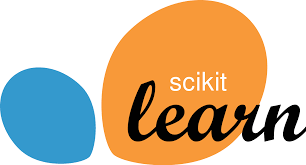
Scikit-learn(Machine Learning Library) is a robust python machine learning library widely used for machine learning tasks. It provides a consistent interface to a variety of supervised and unsupervised learning algorithms.
Core Functionalities:
- Classification: Categorize data points into predefined classes (e.g., spam detection, image recognition).
- Regression: Predict continuous numerical values (e.g., housing price prediction).
- Clustering: Group similar data points together without predefined labels (e.g., customer segmentation).
- Model Selection: Evaluate and compare different algorithms for a given problem.
- Preprocessing: Prepare data for machine learning (e.g., handling missing values, feature scaling).
Key Features:
- User-friendly API: Offers a consistent interface for various algorithms.
- Efficiency: Optimized for performance on large datasets.
- Versatility: Covers a wide range of machine learning techniques.
- Documentation: Comprehensive documentation and tutorials.
- Community: Strong community support and active development.
Common Use Cases:
- Data Analysis: Explore and understand data patterns.
- Predictive Modeling: Build models to make predictions on new data.
- Machine Learning Pipelines: Create end-to-end workflows for data processing and modeling.
By mastering Scikit-learn, you can tackle complex machine learning challenges and extract valuable insights from your data.
NumPy: The Foundation of Python’s Numerical Computing

NumPy(Machine Learning Library), short for Numerical Python, is a fundamental python machine learning library for performing numerical operations on large datasets efficiently. It provides high-performance multi-dimensional array objects, along with tools for working with these arrays.
Core Features:
- Multi-dimensional Arrays: NumPy’s ndarray is the primary data structure, allowing you to create and manipulate arrays of any dimension.
- Array Operations: Perform arithmetic, logical, and statistical operations on entire arrays at once, leading to significant speed improvements compared to traditional Python lists.
- Broadcasting: Perform operations between arrays of different shapes efficiently.
- Indexing and Slicing: Access and modify array elements with flexible indexing and slicing mechanisms.
- Linear Algebra: Includes functions for linear algebra operations like matrix multiplication, inversion, and solving linear equations.
- Random Number Generation: Generate random numbers from various distributions.
Common Use Cases:
- Scientific Computing: NumPy(Machine Learning Library) is used extensively in scientific and engineering applications for tasks like data analysis, numerical simulations, and image processing.
- Machine Learning: It serves as a foundation for many machine learning libraries, providing efficient data structures and operations.
- Data Analysis: NumPy is often used for data manipulation and preprocessing before applying more complex analysis techniques.
- Financial Modeling: It’s employed in financial modeling and quantitative finance for numerical computations.
Example:
import numpy as np
# Create a NumPy array
arr = np.array([1, 2, 3, 4, 5])
# Perform operations on the array
result = arr * 2
print(result) # Output: [2 4 6 8 10]
# Access elements
first_element = arr[0]
print(first_element) # Output: 1
Key Benefits:
- Performance: NumPy’s operations are significantly faster than Python’s built-in lists due to its implementation in C.
- Efficiency: It provides efficient memory management and data storage.
- Versatility: NumPy can handle large datasets and complex computations effectively.
- Integration: It seamlessly integrates with other scientific Python libraries like SciPy, Pandas, and Matplotlib.
By mastering NumPy, you’ll gain a solid foundation for tackling a wide range of numerical computing tasks in Python.
SciPy: The Backbone of Scientific Computing in Python

SciPy(Machine Learning Library), short for Scientific Python, is a cornerstone library in the Python ecosystem for scientific computing. Built on top of NumPy, it provides a vast array of functions for:
Optimization: Solving minimization and maximization problems, essential for machine learning and engineering.
Linear algebra: Performing operations on matrices and vectors, crucial for data analysis and numerical methods.
Integration: Calculating definite and indefinite integrals for various functions.
Interpolation: Estimating values between known data points.
Fourier transforms: Analyzing frequency components of signals.
Special functions: Accessing a wide range of mathematical functions.
Statistics: Performing statistical tests and data analysis.
SciPy’s efficiency stems from its integration with NumPy’s array operations and its underlying implementations in C and Fortran. This combination offers both high-level Python syntax and performance comparable to compiled languages.
Whether you’re a scientist, engineer, or data analyst, SciPy’s comprehensive toolkit empowers you to tackle complex numerical problems effectively.
SciPy Toolbox
SciPy(Machine Learning Library), short for Scientific Python, is a powerful library built on top of NumPy, offering a wide range of algorithms for scientific computing. It’s essential for tasks like optimization, integration, interpolation, linear algebra, and signal processing.
Key Features:
- Optimization: Find optimal solutions to mathematical problems.
Python
from scipy.optimize import minimize def f(x): return (x-2)**2 result = minimize(f, x0=0) - Integration: Calculate definite integrals numerically.
Python
from scipy.integrate import quad import numpy as np def f(x): return np.sin(x) integral, error = quad(f, 0, np.pi/2) - Interpolation: Estimate values between known data points.
Python
from scipy.interpolate import interp1d import numpy as np x = np.linspace(0, 10, 10) y = np.sin(x) f = interp1d(x, y) new_x = np.linspace(0, 10, 50) new_y = f(new_x) - Linear Algebra: Perform matrix operations, solve linear equations, and more.
Python
from scipy import linalg A = np.array([[1, 2], [3, 4]]) inv_A = linalg.inv(A)
SciPy’s versatility makes it a cornerstone in scientific Python workflows, often used in conjunction with NumPy, Pandas, and Matplotlib for comprehensive data analysis and modeling.
Theano: A Legacy in Deep Learning

While Theano(Machine Learning Library) was once a cornerstone in the Python deep learning ecosystem, it’s crucial to understand its current status in 2024.
Theano’s Past Glory
Theano was a python machine learning library that allowed you to define, optimize, and evaluate mathematical expressions, especially those involving multi-dimensional arrays. It was specifically designed for efficient computation of mathematical expressions on GPUs, making it a popular choice for deep learning research. Its key features included:
- Symbolic differentiation: Automatic computation of gradients.
- GPU support: Accelerated computations on graphics cards.
- Stable and efficient numerical computations: Minimizing errors.
- Dynamic C code generation: Optimization for speed.
The Decline of Theano
Despite its strengths, Theano(Machine Learning Library) faced challenges that led to its decline:
- Steep learning curve: Its complexity made it difficult for beginners.
- Maintenance challenges: Keeping up with evolving hardware and software was demanding.
- Competing libraries: TensorFlow and PyTorch emerged with more user-friendly interfaces and active development.
As a result, Theano’s development officially ended in September 2017.
Why Not Use Theano in 2024?
- Lack of support: No bug fixes, updates, or community support.
- Performance limitations: Newer libraries often outperform Theano.
- Compatibility issues: Issues with modern hardware and software.
Modern Alternatives
If you’re looking for tools for deep learning in 2024, consider these alternatives:
- TensorFlow: Offers a comprehensive ecosystem for machine learning, with strong support for large-scale models and deployment.
- PyTorch: Known for its flexibility and ease of use, popular for research and prototyping.
- Keras: A high-level API built on top of TensorFlow or Theano (though the Theano backend is no longer supported).
Example: A Simple Linear Regression in TensorFlow
While not directly comparable to Theano(Machine Learning Library), here’s a basic linear regression example in TensorFlow to illustrate the modern approach:
import tensorflow as tf
# Sample data
X = tf.constant([[1, 2], [3, 4]])
y = tf.constant([3, 7])
# Model
model = tf.keras.Sequential([
tf.keras.layers.Dense(1, input_shape=[2])
])
# Loss function and optimizer
model.compile(loss='mean_squared_error', optimizer='sgd')
# Training
model.fit(X, y, epochs=100)While Theano played a vital role in the history of deep learning, it’s no longer a viable option for new projects. The landscape has evolved, and modern libraries like TensorFlow and PyTorch offer significantly more advantages in terms of performance, ease of use, and community support.
Plotly: A Powerful Visualization Library for Python
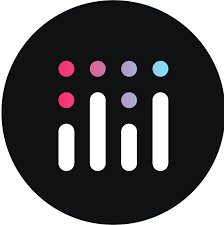
Plotly(Machine Learning Library) is a versatile python machine learning library that excels in creating interactive and visually appealing data visualizations. It supports a wide range of plot types, from simple line charts to complex 3D surfaces and statistical charts. Here’s a basic introduction:
Installation:
To use Plotly, you’ll need to install it using pip:
pip install plotly
Basic Import:
import plotly.express as px
Creating a Simple Plot:
Let’s create a basic line chart to visualize the relationship between two variables:
import plotly.express as px
import pandas as pd
# Sample data
data = {'x': [1, 2, 3, 4, 5], 'y': [1, 4, 9, 16, 25]}
df = pd.DataFrame(data)
# Create the figure
fig = px.line(df, x='x', y='y', title='Simple Line Plot')
# Show the plot
fig.show()
Exploring Plotly Express:
Plotly(Machine Learning Library) Express is a high-level interface for creating common plot types quickly. It simplifies the process of creating visualizations by providing a declarative syntax.
- Line plots:
px.line - Scatter plots:
px.scatter - Bar charts:
px.bar - Histograms:
px.histogram - Box plots:
px.box - Heatmaps:
px.imshow - 3D scatter plots:
px.scatter_3d - Geographic maps:
px.choropleth,px.scatter_geo - And many more…
Customizations:
Plotly(Machine Learning Library) offers extensive customization options to tailor your plots to your specific needs. You can modify colors, markers, line styles, axis labels, titles, and more.
fig.update_layout(
title_text="Customized Line Plot",
xaxis_title="X Values",
yaxis_title="Y Values",
font=dict(
family="Courier New, monospace",
size=18,
color="RebeccaPurple"
)
)
Interactive Features:
One of Plotly’s standout features is its interactivity. You can zoom, pan, hover over data points, and explore your data dynamically.
Subplots:
Create complex visualizations by combining multiple plots into a single figure using subplots.
import plotly.graph_objects as go
fig = make_subplots(rows=1, cols=2)
# Add traces
fig.add_trace(go.Scatter(x=[1, 2, 3], y=[1, 4, 9]), row=1, col=1)
fig.add_trace(go.Bar(x=[1, 2, 3], y=[2, 6, 10]), row=1, col=2)
fig.show()
Beyond the Basics:
Plotly’s capabilities extend far beyond these examples. You can create highly customized and interactive visualizations for various domains, including finance, science, engineering, and more. Explore the official Plotly documentation for in-depth tutorials and advanced features.
Key Points:
- Plotly is a versatile python machine learning library for creating interactive visualizations.
- Plotly Express simplifies the creation of common plot types.
- Customize your plots extensively to match your style and needs.
- Explore interactive features to gain insights from your data.
By mastering Plotly(Machine Learning Library), you can effectively communicate complex data stories and uncover valuable patterns in your datasets.
CatBoost: A Powerful Gradient Boosting Library in Python

CatBoost(Machine Learning Library) is a high-performance, open-source gradient boosting library developed by Yandex. While not a Python language itself, it offers a robust Python interface, making it a popular choice for data scientists and machine learning practitioners. It’s particularly well-suited for handling categorical features, a common challenge in many real-world datasets.
Key Features of CatBoost
- Efficient Handling of Categorical Features: CatBoost automatically handles categorical features without requiring extensive preprocessing, making it a time-saver for many datasets.
- Robust to Overfitting: CatBoost incorporates techniques like ordered boosting and symmetric trees to prevent overfitting, leading to more reliable models.
- High Performance: It’s optimized for speed and memory efficiency, allowing you to train models quickly, even on large datasets.
- Support for Different Objective Functions: CatBoost(Machine Learning Library) supports a variety of objective functions, making it versatile for different types of problems (regression, classification, ranking, etc.).
- Python Interface: The Python API is user-friendly and integrates seamlessly with the Python data science ecosystem.
Example: CatBoost for Classification
import pandas as pd
from catboost import CatBoostClassifier
# Load data
data = pd.read_csv('your_data.csv')
X = data.drop('target', axis=1)
y = data['target']
# Create a CatBoost classifier
model = CatBoostClassifier(
iterations=1000, # Number of trees
learning_rate=0.1,
depth=6,
loss_function='Logloss',
eval_metric='AUC',
cat_features=categorical_features # Indices of categorical features
)
# Train the model
model.fit(X, y, eval_set=(X_val, y_val)) # Optional validation set
# Make predictions
predictions = model.predict(X_test)
In this example:
categorical_featuresis a list of indices indicating which columns in your data are categorical.eval_setis an optional parameter to provide a validation set for monitoring performance during training.
Why CatBoost?
CatBoost’s ability to handle categorical features effectively, coupled with its strong performance and robustness, makes it a compelling choice for many machine learning tasks. It often yields competitive results compared to other gradient boosting libraries like XGBoost and LightGBM.
Additional Tips:
- Experiment with different hyperparameters to optimize model performance.
- Consider using feature importance to understand which features are most influential.
- Explore advanced features like custom loss functions and early stopping for further customization.
By understanding CatBoost’s strengths and effectively utilizing its features, you can build powerful and accurate machine learning models for a variety of applications.
Bokeh: A python machine learning library for Interactive Data Visualization

Bokeh(Machine Learning Library) is a powerful python machine learning library specifically designed for creating interactive visualizations. It’s renowned for its ability to produce high-quality, web-based graphics that are both visually appealing and highly interactive.
Core Features
- Interactive Plots: Bokeh’s primary strength lies in its ability to create dynamic visualizations that users can explore through zooming, panning, hovering, and other interactive elements.
- Web-Based Output: Bokeh generates visualizations that can be directly displayed in web browsers, making them accessible to a wide audience without requiring specialized software.
- Customization: The library offers extensive options to tailor visualizations to specific needs, including control over colors, fonts, markers, and overall layout.
- Performance: Bokeh is optimized to handle large datasets efficiently, ensuring smooth interactions even with complex visualizations.
- Integration: It seamlessly integrates with other Python data analysis libraries like NumPy, Pandas, and Scikit-learn, making it a versatile tool for data scientists.
How Bokeh Works
Bokeh(Machine Learning Library) operates on a client-server architecture. The Python code generates the visualization, which is then sent to a web browser for display. This approach allows for rich interactivity and dynamic updates.
A Simple Example
from bokeh.plotting import figure, show
from bokeh.models import ColumnDataSource
# Sample data
x = [1, 2, 3, 4, 5]
y = [6, 7, 2, 3, 5]
# Create a ColumnDataSource
source = ColumnDataSource(data=dict(x=x, y=y))
# Create a figure
p = figure(title="Simple line plot", x_axis_label='x', y_axis_label='y')
# Add a line glyph
p.line(x='x', y='y', source=source, line_width=2)
# Show the plot
show(p)
This code creates a basic line plot. The ColumnDataSource is used to efficiently manage data, and the figure object provides a canvas for plotting. The line glyph renders the data as a line.
Beyond the Basics
Bokeh’s capabilities extend far beyond simple plots. It offers:
- Geospatial Visualization: Create maps and overlays to visualize geographic data.
- Statistical Plots: Generate various statistical charts like histograms, box plots, and scatter plots.
- Custom Glyphs: Design custom shapes and markers to represent data uniquely.
- Interactive Widgets: Incorporate sliders, buttons, and other widgets to control plot parameters.
- Dashboards: Build complex dashboards to monitor and analyze data.
Use Cases
Bokeh is used across various fields:
- Data Exploration: Quickly visualize data to uncover trends and patterns.
- Scientific Visualization: Represent complex scientific data in a visually understandable manner.
- Financial Analysis: Create interactive financial charts and dashboards.
- Web Applications: Embed visualizations into web applications for data-driven insights.
Bokeh(Machine Learning Library) is a valuable tool for anyone working with data who needs to create interactive and informative visualizations. Its flexibility, performance, and ease of use make it a popular choice for data scientists, analysts, and developers.
By mastering Bokeh, you can effectively communicate complex information, uncover hidden insights, and enhance decision-making processes.
spaCy: A python machine learning library for Natural Language Processing
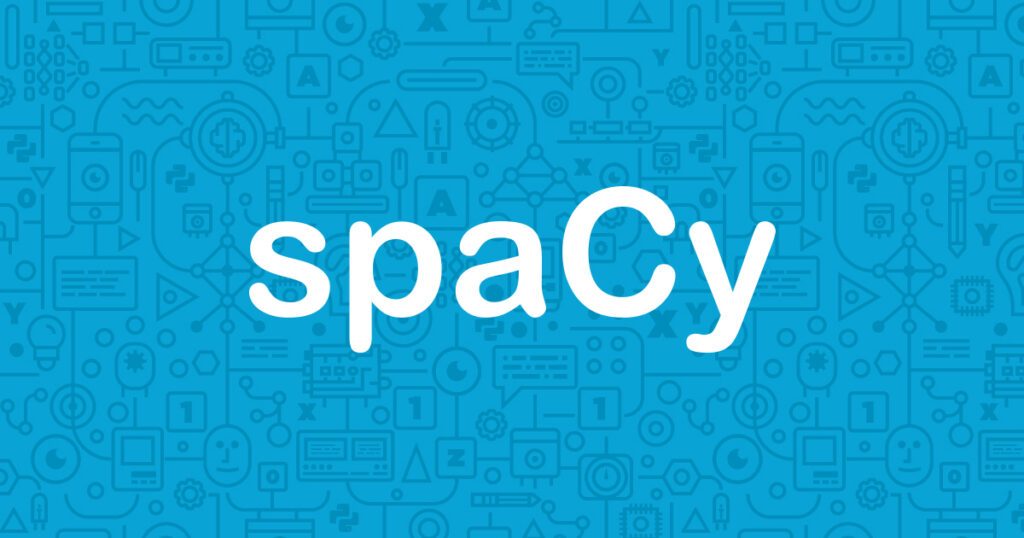
spaCy(Machine Learning Library) is a powerful and efficient python machine learning library designed specifically for natural language processing (NLP) tasks. It offers a streamlined interface and high performance, making it a popular choice for both researchers and industry professionals.
Core Features
- Speed and Efficiency: spaCy is renowned for its speed, handling large text datasets efficiently. It’s optimized for production environments, allowing for real-time processing.
- Accuracy: The library provides pre-trained models for various languages, delivering state-of-the-art accuracy in tasks like named entity recognition, part-of-speech tagging, dependency parsing, and more.
- Customizable Pipelines: spaCy allows you to create custom NLP pipelines tailored to specific tasks. You can add or remove components as needed, making it adaptable to different use cases.
- Integration: It seamlessly integrates with other Python libraries and frameworks, such as NumPy, Pandas, and machine learning libraries, facilitating end-to-end data processing workflows.
Key Components
- Tokenization: spaCy(Machine Learning Library) accurately splits text into individual words or tokens, considering language-specific rules and punctuation.
- Part-of-Speech Tagging: It assigns grammatical labels to words, such as noun, verb, adjective, etc., providing insights into sentence structure.
- Named Entity Recognition (NER): spaCy identifies and classifies named entities like persons, organizations, locations, dates, and quantities within text.
- Dependency Parsing: It reveals the grammatical relationships between words in a sentence, creating a dependency tree for analysis.
- Vector Models: spaCy offers word embeddings, which represent words as numerical vectors, enabling semantic and syntactic analysis.
Example: Named Entity Recognition
import spacy
# Load the English language model
nlp = spacy.load("en_core_web_sm")
# Process a text
text = "Apple is looking at buying U.K. startup for $1 billion"
doc = nlp(text)
# Print detected entities
for ent in doc.ents:
print(ent.text, ent.label_)
This code will output:
Apple ORG
U.K. GPE
$1 billion MONEY
Applications
spaCy(Machine Learning Library) finds applications in a wide range of fields:
- Information Extraction: Extracting key information from text, such as product details, contact information, or event summaries.
- Text Classification: Categorizing text into predefined classes, like sentiment analysis, topic modeling, or spam detection.
- Machine Translation: Improving translation quality by leveraging language-specific patterns and structures.
- Question Answering: Building systems that can answer questions based on given text data.
- Chatbots and Virtual Assistants: Understanding and responding to user queries in a natural language interface.
spaCy’s combination of speed, accuracy, and flexibility makes it a valuable tool for developers and researchers working with text data.
TensorFlow: A Powerful python machine learning library for Machine Learning
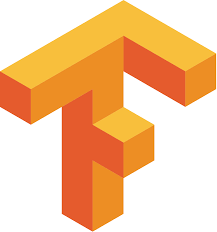
TensorFlow(Machine Learning Library) is an open-source python machine learning library developed by Google Brain for machine learning and artificial intelligence. It provides a comprehensive ecosystem of tools, libraries, and community resources that enable researchers and developers to build and deploy machine learning models efficiently.
Core Features of TensorFlow
- Tensor Manipulation: TensorFlow excels at handling multi-dimensional arrays known as tensors, which are fundamental to numerical computations in machine learning.
- Deep Learning: It offers high-level APIs like Keras for building and training complex neural networks, making it accessible to both beginners and experienced practitioners.
- Deployment: TensorFlow Lite enables deployment of models on mobile and embedded devices, while TensorFlow Serving facilitates serving models in production environments.
- Scalability: It supports distributed training across multiple GPUs and TPUs, allowing for handling massive datasets and complex models.
- Flexibility: TensorFlow provides a flexible architecture that can be used for a wide range of machine learning tasks, including image recognition, natural language processing, and time series analysis.
A Simple Example
import tensorflow as tf
# Create some tensors
x = tf.constant([[1, 2], [3, 4]])
y = tf.constant([[5, 6], [7, 8]])
# Perform a matrix multiplication
z = tf.matmul(x, y)
# Print the result
print(z)
This code demonstrates basic tensor operations in TensorFlow.
Key Advantages of TensorFlow
- Large and Active Community: A vast community of developers contributes to TensorFlow, providing extensive support and resources.
- Industry Adoption: Widely used by major tech companies and organizations, ensuring its stability and relevance.
- Comprehensive Ecosystem: Offers a rich set of tools and libraries for various machine learning tasks, making it a one-stop solution.
- Performance: Optimized for performance on different hardware platforms, including CPUs, GPUs, and TPUs.
TensorFlow in 2024
TensorFlow(Machine Learning Library) continues to evolve rapidly, with new features and improvements being introduced regularly. In 2024, it remains a leading choice for machine learning development, offering cutting-edge capabilities and a strong foundation for building intelligent applications.
Beyond the Basics
TensorFlow’s potential extends far beyond simple examples. It can be used for building sophisticated models for image classification, natural language processing, recommendation systems, and more. Its ability to handle large-scale datasets and complex architectures makes it a powerful tool for addressing real-world challenges.
By mastering TensorFlow(Machine Learning Library), you can unlock the potential of machine learning and contribute to innovative solutions across various industries.
Keras: A High-Level Deep Learning Library

Keras is a powerful and user-friendly python machine learning library that simplifies the process of building and training deep neural networks. Designed for rapid experimentation, it offers a high-level API that abstracts away much of the underlying complexity, making it accessible to both beginners and experienced machine learning practitioners.
Core Features
- User-Friendly API: Keras(Machine Learning Library) provides a clean and intuitive interface for defining neural network models, making it easy to experiment with different architectures.
- Modularity: The library is built on a modular principle, allowing you to easily combine different components (layers, optimizers, loss functions) to create custom models.
- Flexibility: Keras runs seamlessly on both CPU and GPU, making it suitable for a wide range of computational resources. It also supports multiple backend engines, including TensorFlow and Theano.
- Rapid Development: By handling many low-level operations, Keras accelerates the development process, allowing you to focus on model architecture and hyperparameter tuning.
- Extensibility: While providing a high-level API, Keras also offers flexibility for advanced users who want to customize specific components.
Building a Simple Neural Network with Keras
from tensorflow.keras.models import Sequential
from tensorflow.keras.layers import Dense
# Create a sequential model
model = Sequential()
# Add layers
model.add(Dense(32, activation='relu', input_dim=784))
model.add(Dense(10, activation='softmax'))
# Compile the model
model.compile(loss='categorical_crossentropy', optimizer='adam', metrics=['accuracy'])
# Train the model
model.fit(x_train,
y_train, epochs=5, batch_size=32)
This code demonstrates how to create a simple neural network for a classification task. The Sequential model is a linear stack of layers. Dense layers are fully connected layers, and activation specifies the activation function for each layer. The compile method defines the loss function, optimizer, and metrics to monitor during training. Finally, the fit method trains the model on the provided training data.
Use Cases
Keras is widely used in various domains, including:
- Image recognition: Classifying images, object detection, image segmentation.
- Natural language processing: Text classification, sentiment analysis, machine translation.
- Time series analysis: Forecasting, anomaly detection.
- Generative models: Creating new data instances (e.g., image generation, text generation).
Integration with TensorFlow
Keras(Machine Learning Library) is now officially integrated with TensorFlow, providing access to a vast ecosystem of tools and resources. This integration brings together the ease of use of Keras with the scalability and performance of TensorFlow.
In conclusion, Keras has become a cornerstone in the deep learning landscape due to its user-friendly interface, flexibility, and integration with powerful backend engines. Its ability to accelerate development and experimentation makes it a valuable tool for both beginners and experienced practitioners.
Matplotlib: A Versatile Python Visualization Library

Matplotlib(Machine Learning Library) is a cornerstone in the Python data visualization ecosystem. It’s a comprehensive library for creating static, animated, and interactive visualizations. Its flexibility, customization options, and extensive feature set make it a go-to choice for data scientists, engineers, and researchers.
Core Features
- Static Plots: Matplotlib excels at producing high-quality static visualizations in various formats like PNG, PDF, and SVG. This makes it suitable for publication-ready figures.
- Customizability: Users have granular control over every aspect of a plot, from colors and line styles to axis labels and tick marks. This level of customization allows for tailored visualizations to match specific requirements.
- Plot Types: Matplotlib supports a wide range of plot types, including line plots, scatter plots, bar charts, histograms, pie charts, box plots, error bars, and many more.
- Subplots: Create complex visualizations by arranging multiple plots within a single figure.
- Annotations: Add text, arrows, and other annotations to enhance plot clarity and readability.
- 3D Plotting: Visualize data in three dimensions using Matplotlib’s 3D toolkit.
How Matplotlib Works
Matplotlib’s architecture revolves around the concept of figures and axes. A figure is the top-level container for all plot elements, while axes represent the plotting area itself. This structure provides a foundation for building intricate visualizations.
A Simple Example
import matplotlib.pyplot as plt
import numpy as np
# Sample data
x = np.linspace(0, 10, 100)
y = np.sin(x)
# Create a figure and axes
fig, ax = plt.subplots()
# Plot the data
ax.plot(x, y)
# Customize the plot
ax.set_title("Sine Curve")
ax.set_xlabel("x")
ax.set_ylabel("y")
# Show the plot
plt.show()
This code generates a simple line plot of a sine curve.
Beyond the Basics
Matplotlib(Machine Learning Library) offers advanced features for sophisticated visualizations:
- Interactive Plots: While not its primary strength, Matplotlib can create interactive plots using tools like
mpld3oripympl. - Animations: Create dynamic visualizations that showcase data changes over time.
- Customizing Styles: Apply predefined or custom stylesheets to modify the overall appearance of plots.
- Integration: Seamlessly integrate with other Python libraries like NumPy, Pandas, and SciPy for data processing and analysis.
Advantages and Disadvantages
Advantages:
- Extensive customization options
- Wide range of plot types
- Mature and well-documented
- Large community and support resources
- Integration with other scientific Python libraries
Disadvantages:
- Can be verbose for complex visualizations
- Steeper learning curve compared to some high-level libraries
- Interactive capabilities might not be as robust as dedicated libraries
Matplotlib(Machine Learning Library) remains a powerful and versatile tool for data visualization in Python. Its ability to create publication-quality figures and its deep customization options make it a preferred choice for many users. While newer libraries offer higher-level abstractions, Matplotlib’s foundation in the Python ecosystem ensures its continued relevance in data exploration and communication.
LightGBM: A Powerful Gradient Boosting Framework

LightGBM(Machine Learning Library), short for Light Gradient Boosting Machine, is a high-performance gradient boosting framework designed for efficient handling of large datasets. It’s particularly well-suited for tasks involving classification, regression, and ranking. Built on the Gradient Boosting Decision Tree (GBDT) algorithm, LightGBM introduces several optimizations to accelerate training speed and improve accuracy.
Core Principles of LightGBM
LightGBM’s efficiency stems from several key innovations:
- Gradient-Based One-Side Sampling (GOSS): This technique focuses on data points with large gradients, which are more informative for model training. By down-sampling data points with small gradients, LightGBM reduces computational cost without sacrificing accuracy.
- Exclusive Feature Bundling (EFB): LightGBM can bundle features together if their values are similar, reducing the dimensionality of the data. This leads to faster training and smaller model size.
- Histogram-based Algorithm: Instead of calculating exact gains for each data point, LightGBM uses histograms to approximate gains, significantly speeding up the training process.
Advantages of LightGBM
- Speed: LightGBM(Machine Learning Library) is renowned for its fast training speed, making it suitable for large datasets.
- Accuracy: Despite its speed, LightGBM often achieves state-of-the-art accuracy on various machine learning tasks.
- Memory Usage: It’s efficient in terms of memory usage, allowing it to handle datasets that might be challenging for other gradient boosting frameworks.
- Versatility: LightGBM supports various loss functions and can be applied to different types of problems.
- Scalability: It can handle large-scale datasets and distributed computing environments.
A Basic Example
import lightgbm as lgb
from sklearn.model_selection import train_test_split
from sklearn.datasets import load_iris
from sklearn.metrics import accuracy_score
# Load the Iris dataset
iris = load_iris()
X, y = iris.data, iris.target
# Split the data into training and testing
sets
X_train, X_test, y_train, y_test = train_test_split(X, y, test_size=0.2, random_state=42)
# Create LightGBM dataset
train_data = lgb.Dataset(X_train, label=y_train)
test_data = lgb.Dataset(X_test, label=y_test)
# Set parameters
params = {
'objective': 'multiclass',
'num_class': 3,
'metric': 'multi_logloss',
'num_leaves': 31,
'learning_rate': 0.1,
'feature_fraction': 0.9,
'bagging_fraction': 0.8,
'bagging_freq':5
}
# Train the model
model = lgb.train(params, train_data, valid_sets=[test_data], num_boost_round=100, early_stopping_rounds=10)
# Make predictions
y_pred = model.predict(X_test)
y_pred = [list(p).index(max(p)) for p in y_pred]
# Evaluate accuracy
accuracy = accuracy_score(y_test, y_pred)
print("Accuracy:", accuracy)
Key Points in the Example
- Import necessary libraries: Import LightGBM, scikit-learn, and metrics for evaluation.
- Load and split data: Use the Iris dataset as an example, split it into training and testing sets.
- Create LightGBM datasets: Convert data into LightGBM’s Dataset format.
- Set parameters: Define hyperparameters for the model, including objective, number of classes, metric, and other tuning parameters.
- Train the model: Train the LightGBM model using the training data and evaluate on the validation set.
- Make predictions: Predict labels for the test set.
- Evaluate accuracy: Calculate accuracy to assess the model’s performance.
LightGBM(Machine Learning Library) has become a popular choice for gradient boosting due to its exceptional speed, accuracy, and efficiency. Its ability to handle large datasets and complex problems makes it a valuable tool for data scientists and machine learning practitioners. By understanding its core principles and effectively tuning hyperparameters, you can leverage LightGBM to build powerful predictive models.
Scrapy: A Powerful python machine learning library for Web Scraping

Scrapy(Machine Learning Library) is a robust Python framework designed specifically for web scraping. It provides a comprehensive toolkit for extracting data from websites efficiently and effectively. Its flexibility, scalability, and asynchronous nature make it a preferred choice for many data extraction projects.
Core Components of Scrapy
Scrapy is structured around several key components:
- Spider: The core component, responsible for defining how to crawl a website. It specifies the initial URL, how to follow links, and how to extract data from the pages.
- Item: Represents a piece of data extracted from a website. It’s a Python class defining the structure of the scraped data.
- Item Pipeline: Processes scraped items. It can perform various functions like cleaning, validating, storing data in databases, or exporting to CSV or JSON files.
- Downloader: Handles fetching web pages. It includes features like caching, user-agent, cookies, and proxies.
- Scheduler: Manages the order in which pages are downloaded.
- Engine: Orchestrates the whole scraping process, coordinating the interaction between different components.
Writing a Simple Scrapy Spider
To illustrate how Scrapy(Machine Learning Library) works, let’s create a basic spider to extract product names and prices from a simple e-commerce website.
import scrapy
class ProductSpider(scrapy.Spider):
name = "product_spider"
allowed_domains = ["example.com"]
start_urls = ["http://example.com/products"]
def parse(self, response):
for product in response.css('div.product'):
yield {
'name': product.css('h3::text').get(),
'price': product.css('span.price::text').get(),
}
In this example:
ProductSpideris the name of our spider.allowed_domainsspecifies the website to crawl.start_urlsis a list of starting URLs.parseis the method that handles the response from a downloaded page. It extracts product names and prices using CSS selectors.
Key Features and Advantages of Scrapy
- Asynchronous: Scrapy can handle multiple requests concurrently, significantly improving performance.
- Item Pipelines: Offers flexibility in processing extracted data.
- Selectors: Provides powerful tools for extracting data from HTML/XML content.
- Middleware: Extends Scrapy’s functionality with custom components.
- Built-in Support: Includes features like caching, error handling, and automatic retries.
- Large Community: A strong community provides support and resources.
Common Use Cases
Scrapy(Machine Learning Library) is used in various applications:
- Data Extraction: Gathering product information, news articles, real estate listings, etc.
- Price Monitoring: Tracking prices of products across different websites.
- Market Research: Collecting data for market analysis and trend identification.
- SEO: Analyzing competitor websites and gathering SEO data.
- Research: Extracting data for academic research projects.
Best Practices
- Respect Website Terms of Service: Adhere to website policies and robots.txt.
- Handle Errors Gracefully: Implement proper error handling to avoid data loss.
- Optimize Performance: Use techniques like caching, asynchronous requests, and efficient selectors.
- Consider Legal and Ethical Implications: Be aware of copyright and privacy laws.
- Test Thoroughly: Ensure your spider extracts data correctly and handles different page structures.
By following these guidelines and leveraging Scrapy’s capabilities, you can effectively extract valuable data from the web and gain insights for your projects.
Gensim: A python machine learning library for Topic Modeling and Document Similarity

Gensim(Machine Learning Library) is a python machine learning library specifically designed for natural language processing (NLP) tasks, with a particular focus on topic modeling and document similarity. It offers efficient implementations of various algorithms, making it a popular choice for researchers and practitioners in the field.
Core Functionalities of Gensim
- Topic Modeling: Gensim provides tools for uncovering latent semantic structures within a collection of documents. Algorithms like Latent Dirichlet Allocation (LDA), Latent Semantic Analysis (LSA), and Non-Negative Matrix Factorization (NMF) are available for this purpose.
- Document Similarity: The library offers methods to calculate the semantic similarity between documents. Techniques such as TF-IDF (Term Frequency-Inverse Document Frequency) and word embeddings (Word2Vec, FastText) are supported.
- Vector Space Modeling: Gensim can create vector representations of documents, which are essential for many NLP tasks. It provides efficient implementations for various vector space models.
- Document Indexing: The library offers indexing capabilities for large corpora, allowing for efficient retrieval and processing of documents.
How Gensim Works
Gensim(Machine Learning Library) works by representing documents as numerical vectors. These vectors can be created using different techniques, such as bag-of-words, TF-IDF, or word embeddings. Once documents are represented as vectors, various algorithms can be applied to extract information or find relationships between them.
Example: Topic Modeling with Gensim
import gensim
from gensim.corpora import Dictionary
from gensim.models import LdaModel
# Sample text data
documents = [
"Human machine interface for lab abc computer applications",
"A survey of user opinion of computer system response time",
"The EPS user interface management system",
"System and human system engineering testing of EPS", ]
# Create a dictionary
dictionary = Dictionary(documents)
# Create document-term matrix
doc_term_matrix = [dictionary.doc2bow(doc) for doc in documents]
# Create LDA model
lda_model = LdaModel(doc_term_matrix, num_topics=2, id2word=dictionary, passes=15)
# Print topics
for topic in lda_model.print_topics():
print(topic)
This code snippet demonstrates how to perform topic modeling on a small dataset using LDA. The output will show the top words for each discovered topic.
Applications of Gensim
Gensim has a wide range of applications in NLP and text mining, including:
- Document Classification: Categorizing documents based on their content.
- Information Retrieval: Finding relevant documents based on user queries.
- Recommendation Systems: Recommending similar items or documents to users.
- Text Summarization: Generating concise summaries of documents.
- Sentiment Analysis: Determining the sentiment expressed in a text.
Gensim(Machine Learning Library) is a powerful and versatile python machine learning library for NLP tasks. Its focus on topic modeling and document similarity, combined with efficient implementations, makes it a valuable tool for researchers and practitioners. By understanding the core concepts and functionalities of Gensim, you can effectively leverage its capabilities to extract valuable insights from textual data.
OpenCV: A Powerful Tool for Computer Vision

OpenCV(Machine Learning Library), short for Open Source Computer Vision Library, is a robust python machine learning library extensively used for real-time computer vision applications. It provides a comprehensive set of functions for image and video processing, feature detection, object tracking, and machine learning.
Core Functionalities of OpenCV
- Image and Video Processing: OpenCV offers a vast array of functions for manipulating images and videos. Tasks like reading, writing, converting color spaces (BGR to RGB, grayscale), resizing, cropping, and applying filters are fundamental operations supported by the library.
- Feature Detection: OpenCV empowers you to detect key points and features within images. Techniques like SIFT, SURF, ORB, and FAST are implemented for identifying distinctive image regions.
- Object Detection and Recognition: The library provides tools for locating and classifying objects in images and videos. You can leverage pre-trained models or train your own models using machine learning techniques.
- Face Recognition: OpenCV(Machine Learning Library) includes algorithms for detecting and recognizing human faces. It can be used for various applications, such as facial recognition systems, attendance systems, and security systems.
- Machine Learning: While primarily a computer vision library, OpenCV also incorporates machine learning modules. You can train classifiers, perform regression analysis, and implement other machine learning tasks.
A Basic Example: Detecting Faces
Key Advantages of OpenCV
- Open Source: OpenCV is freely available for both academic and commercial use, fostering innovation and collaboration.
- Performance: Optimized for real-time applications, OpenCV delivers high performance even on resource-constrained systems.
- Comprehensive: The library offers a wide range of functionalities, making it a one-stop solution for computer vision tasks.
- Large Community: A thriving community of developers contributes to OpenCV’s development and provides support.
Applications of OpenCV
OpenCV(Machine Learning Library) has found applications in numerous fields:
- Autonomous Vehicles: Object detection, lane detection, and pedestrian detection.
- Augmented Reality: Real-time object tracking and overlaying virtual content.
- Medical Image Analysis: Image segmentation, feature extraction, and disease detection.
- Security and Surveillance: Face recognition, object tracking, and anomaly detection.
- Robotics: Visual servoing, object manipulation, and navigation.
OpenCV stands as a cornerstone in the field of computer vision, providing a robust foundation for developing innovative applications. Its extensive capabilities, combined with its open-source nature and performance, make it an indispensable tool for researchers, developers, and engineers alike.
Statsmodels: A python machine learning library for Statistical Modeling

Statsmodels(Machine Learning Library) is a python machine learning library that provides a comprehensive set of tools for statistical data exploration, modeling, and inference. It’s designed to work seamlessly with NumPy arrays and Pandas DataFrames, making it a popular choice for data scientists and researchers.
Core Features
- Descriptive Statistics: Calculate summary statistics like mean, median, standard deviation, correlation, and covariance matrices.
- Exploratory Data Analysis (EDA): Visualize data distributions, identify outliers, and check for relationships between variables using plots like histograms, scatter plots, and box plots.
- Statistical Tests: Perform hypothesis testing for various statistical distributions (normal, t, chi-squared, etc.) and compare groups using t-tests, ANOVA, and non-parametric tests.
- Linear Regression: Fit linear regression models, including multiple linear regression, and assess model performance using metrics like R-squared and adjusted R-squared.
- Generalized Linear Models (GLMs): Model non-normal data with distributions like Poisson, binomial, and negative binomial.
- Time Series Analysis: Analyze time series data, including ARIMA, SARIMA, and other time series models.
- Robust Regression: Handle outliers and heteroscedasticity using robust regression methods.
Example: Linear Regression
import statsmodels.api as sm
import pandas as pd
import numpy as np
# Sample data
data = {'x1': [1, 2, 3, 4, 5],
'x2': [2, 4, 5, 4, 5],
'y': [7, 11, 15, 18, 20]}
df = pd.DataFrame(data)
# Add a constant for the intercept
X = df[['x1', 'x2']]
X = sm.add_constant(X)
y = df['y']
# Fit the linear regression model
model = sm.OLS(y, X).fit()
# Print the model summary
print(model.summary())
This code fits a linear regression model with two predictors (x1 and x2) to the response variable y. The sm.add_constant() function adds an intercept term to the model. The model.summary() method provides a comprehensive output with model coefficients, standard errors, t-values, p-values, R-squared, and other statistics.
Strengths of Statsmodels
- Comprehensive: Covers a wide range of statistical methods.
- Flexibility: Allows customization of models and statistical tests.
- Integration: Works seamlessly with NumPy and Pandas.
- Performance: Efficient for large datasets.
- Documentation: Extensive documentation and examples.
Limitations
- Steeper Learning Curve: Compared to some other libraries, Statsmodels can have a steeper learning curve due to its depth and flexibility.
- Visualization: While it provides basic plotting capabilities, it’s not as feature-rich as specialized visualization libraries like Matplotlib or Seaborn.
In conclusion, Statsmodels is a powerful and versatile python machine learning library for statistical modeling and analysis. It’s an essential tool for data scientists and researchers who need to perform rigorous statistical analysis and modeling.
Pandas: A Powerful Tool for Data Manipulation

Pandas is a high-performance python machine learning library designed for data manipulation and analysis. It provides flexible and efficient data structures, along with a wide range of functions for data cleaning, transformation, and analysis.
Core Data Structures
Pandas(Machine Learning Library) introduces two primary data structures:
- Series: A one-dimensional labeled array capable of holding any data type (integers, floats, strings, objects, etc.). It is similar to a NumPy array but with additional features like indexing by labels.
- DataFrame: A two-dimensional labeled data structure with columns of potentially different types. It is analogous to a spreadsheet or SQL table.
Key Features
- Data Ingestion: Pandas can read data from various file formats (CSV, Excel, JSON, SQL databases, etc.) and load it into DataFrame objects.
- Data Cleaning: It offers functions to handle missing values, duplicates, outliers, and inconsistencies in data.
- Data Manipulation: Pandas provides powerful tools for selecting, filtering, sorting, grouping, and merging datasets.
- Data Analysis: It includes functions for statistical calculations, time series analysis, and exploratory data analysis (EDA).
- Data Visualization: While not primarily a visualization library, Pandas integrates well with plotting libraries like Matplotlib and Seaborn for creating informative visualizations.
Example: Analyzing Sales Data
import pandas as pd
import numpy as np
# Sample sales data
data = {'Product': ['A', 'B', 'A', 'C'],
'Quantity': [3, 4, 1, 2],
'Price': [25, 30, 25, 40]}
df = pd.DataFrame(data)
# Basic operations
print(df.head()) # Display first few rows
print(df.describe()) # Summary statistics
# Data selection
product_a = df[df['Product'] == 'A']
print(product_a)
# Group and aggregate
sales_by_product = df.groupby('Product')['Quantity'].sum()
print(sales_by_product)
# Handling missing values
df['Quantity'] = df['Quantity'].fillna(0) # Fill missing values with 0
# Creating new columns
df['Total_Revenue'] = df['Quantity'] * df['Price']
print(df)
Why Pandas is Essential
Pandas has become an indispensable tool for data scientists, analysts, and engineers due to its:
- Efficiency: Its performance is optimized for handling large datasets.
- Flexibility: It can work with various data types and structures.
- Integration: It seamlessly integrates with other Python libraries for data analysis and machine learning.
- Community: A large and active community contributes to its development and provides extensive support.
Pandas is a cornerstone of the Python data science ecosystem. Its ability to efficiently manipulate and analyze data has made it a preferred choice for a wide range of applications. By mastering Pandas, you’ll gain a powerful toolkit for extracting valuable insights from your data.
PyTorch: A Deep Learning Powerhouse

PyTorch is a Python-based scientific computing library primarily used for deep learning applications. Developed by Facebook’s AI Research lab, it has gained immense popularity due to its flexibility, ease of use, and efficiency.
Core Features
- Tensor Computation: At its core, PyTorch provides a powerful tensor computation framework. Tensors are multi-dimensional arrays similar to NumPy arrays but with GPU acceleration capabilities.
- Autograd: This automatic differentiation package allows for seamless gradient computation, essential for training neural networks.
- Neural Network Modules: PyTorch offers a rich set of pre-built neural network layers and modules, making it easy to construct complex architectures.
- Dynamic Computational Graph: Unlike static frameworks, PyTorch’s dynamic computational graph allows for more flexibility and easier debugging.
- Pythonic Interface: Its Pythonic API makes it intuitive for developers familiar with Python.
- Strong Community: A large and active community contributes to its growth and provides extensive support.
Key Advantages
- Flexibility: PyTorch’s dynamic nature enables rapid prototyping and experimentation.
- Efficiency: Leveraging GPUs, PyTorch can handle large datasets and complex models efficiently.
- Ease of Use: Its Pythonic interface and high-level abstractions simplify development.
- Integration: Seamlessly integrates with other Python libraries like NumPy and Scikit-learn.
- Deployment: Supports deployment to various platforms, including cloud and mobile devices.
A Simple Example
import torch
# Create a tensor
x = torch.tensor([1, 2, 3])
# Perform operations
y = x * 2 + 1
# Print the result
print(y)
This simple example demonstrates tensor creation and basic operations. PyTorch’s true power lies in its ability to handle complex neural networks.
Deep Learning with PyTorch
PyTorch(Machine Learning Library) provides high-level APIs like torch.nn for building neural networks. For instance, to create a simple linear layer:
import torch.nn as nn
# Create a linear layer
linear_layer = nn.Linear(in_features=10, out_features=5)
Training neural networks involves defining a loss function, optimizer, and training loop. PyTorch(Machine Learning Library) simplifies this process with tools like torch.optim for optimizers and torch.autograd for automatic differentiation.
Beyond Deep Learning
While primarily known for deep learning, PyTorch’s tensor computation capabilities extend to other scientific computing domains. It can be used for numerical computations, linear algebra, and more.
Community and Ecosystem
The PyTorch community is vast and active, contributing to its continuous development. Numerous libraries and tools have been built around PyTorch, expanding its capabilities. Some popular examples include:
- Torchvision: For computer vision datasets, models, and transforms.
- Torchtext: For natural language processing datasets, preprocessing, and models.
- PyTorch Lightning: For simplifying training and scaling deep learning models.
PyTorch has become a preferred choice for researchers and practitioners in academia and industry due to its versatility, performance, and ease of use. Its ability to handle complex deep learning models, coupled with its strong community and ecosystem, solidifies its position as a leading deep learning framework.
Seaborn: A High-Level Data Visualization Library in Python

Seaborn is a Python data visualization library built on top of Matplotlib. It provides a high-level interface for creating attractive and informative statistical graphics. Designed to make visualization more intuitive and expressive, Seaborn integrates closely with Pandas data structures for seamless data exploration and analysis.
Key Features of Seaborn
- High-level Interface: Seaborn(Machine Learning Library) simplifies the process of creating complex visualizations with a few lines of code.
- Statistical Graphics: It offers a wide range of statistical plot types, including distribution plots, categorical plots, regression plots, and matrix plots.
- Data Integration: Seamlessly works with Pandas DataFrames, providing convenient ways to map data to visual properties.
- Color Palettes: Offers built-in color palettes that enhance visual appeal and consistency.
- Themes and Styles: Customize the overall look and feel of plots with various themes and styles.
Common Plot Types in Seaborn
- Distribution Plots:
distplot: Visualize the distribution of a single variable.jointplot: Explore the relationship between two variables with joint distributions and marginal histograms.pairplot: Visualize relationships between multiple variables in a dataset.
- Categorical Plots:
countplot: Show the counts of observations in each categorical bin.barplot: Visualize the relationship between a numerical and one or more categorical variables.boxplot: Show the distribution of data across different categories.violinplot: Combine boxplot and kernel density estimation for richer visualizations.
- Regression Plots:
regplot: Plot data and a linear regression model fit.lmplot: Explore relationships between multiple variables with linear regression fits.
- Matrix Plots:
heatmap: Visualize rectangular data as a color-encoded matrix.clustermap: Combine hierarchical clustering with heatmaps for data exploration.
Example: Exploring a Dataset with Seaborn
import seaborn as sns
import pandas as pd
import matplotlib.pyplot as plt
# Load the Iris dataset
iris = sns.load_dataset("iris")
# Distribution plot of sepal length
sns.distplot(iris['sepal_length'])
plt.show()
# Pair plot for all numerical columns
sns.pairplot(iris, hue='species')
plt.show()
# Box plot of sepal length by species
sns.boxplot(x='species', y='sepal_length', data=iris)
plt.show()
This example demonstrates how to use Seaborn (Machine Learning Library) to create a distribution plot, a pair plot, and a box plot for the Iris dataset. The code imports necessary libraries, loads the dataset, and then creates the plots using Seaborn’s functions.
Additional Features and Customization
Seaborn offers many more features for customization and advanced visualizations. These include:
- Color palettes: Use predefined or custom color palettes to control plot aesthetics.
- Themes: Apply different themes to change the overall appearance of plots.
- Faceting: Create multiple plots based on different subsets of data.
- Grids: Arrange multiple plots in a grid layout.
- Annotations: Add text, labels, and other annotations to plots.
By mastering these features, you can create informative and visually appealing data visualizations with Seaborn.
Final Thoughts:
In conclusion, Python’s combination of powerful libraries, ease of use, strong community support, flexibility, and integration capabilities has made it the preferred language for machine learning professionals worldwide. Its continued evolution and expansion of the ecosystem ensure its enduring dominance in the field. By mastering Python and its machine learning libraries, data scientists and engineers can effectively tackle complex problems, drive innovation, and extract valuable insights from data.
